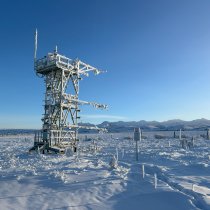A field day for interns
July 17, 2013

Seeing how much planning and constant attention (sampling) must go in to the construction and operation of a single site, not even a single domain, let alone across all domains, made me realize what a huge undertaking the NEON project is. It is really exciting to be a part of something that no one has really tried to do before and to be among people who are also really excited about what NEON is doing; without everyone involved, including headquarters, each individual domain, the larger scientific community, and the general public, this project wouldn’t be what it is.
-Nicole Dear, Terrestrial Ecology InternVisiting the tower was my favorite part. I could see the level of craftsmanship that went behind the engineering and construction of a tower. The soil array was interesting to see as well. I thought adding a roof over the soil was a clever way to prevent possible data contamination. When I heard David talk about how GIS can aid in answering some geographically complex questions in NEON, I realized how versatile GIS can be.
-Adrienne Rodriguez, Aquatics/Geospatial InternEcologists face a daunting task of finding a conclusion from data gathered in an experiment. Everything on Earth is so closely connected that one little change can be linked to dozens of different reasons. Engineering, on the other hand, is wonderfully constrained by physics. Personally, I’ll stick to my concrete engineering, it’s easier. One day, I will see NEON’s published data about stream ecology and say to myself, “my design that I engineered, my baby, gathered that data and in a small way helped save the Earth.
-William Ennis, Engineering Intern


